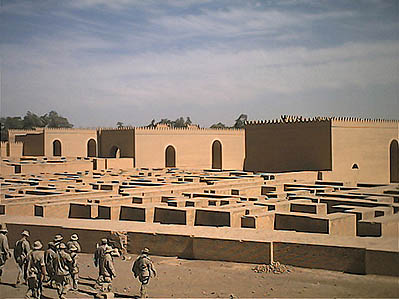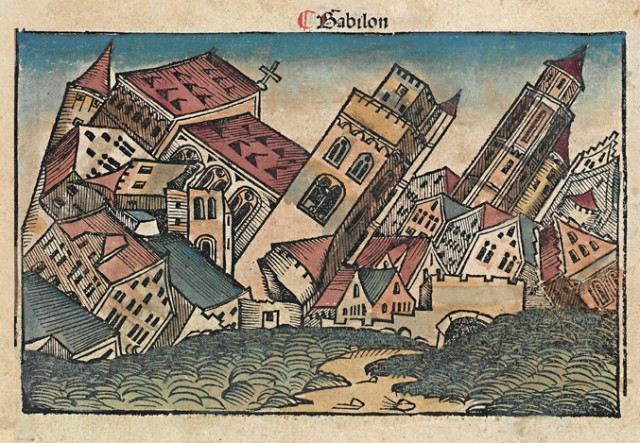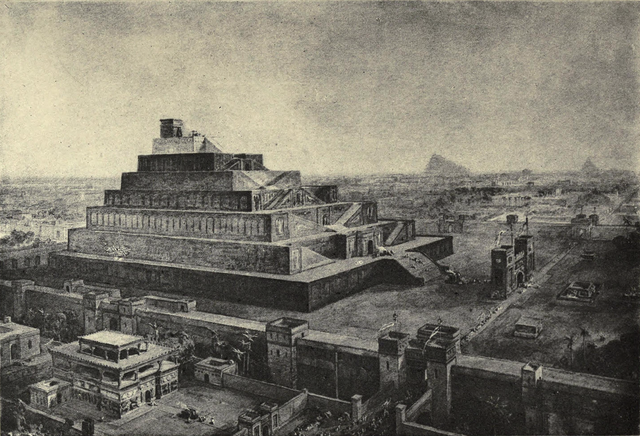
| BABYLON
Babylon
A
partial view of the ruins of Babylon, as seen from Saddam Hussein's
Summer Palace
Babylon was the capital city of the ancient Babylonian empire, which itself is a term referring to either of two separate empires in the Mesopotamian area in antiquity. These two empires achieved regional dominance between the 19th and 15th centuries BC, and again between the 7th and 6th centuries BC. The city, built along both banks of the Euphrates river, had steep embankments to contain the river's seasonal floods. The earliest known mention of Babylon as a small town appears on a clay tablet from the reign of Sargon of Akkad (2334–2279 BC) of the Akkadian Empire. The site of the ancient city lies just south of present-day Baghdad. The last known record of habitation of the town dates from the 10th century AD, when it was referred to [by whom?] as the small village of Babel.
The town became part of a small independent city-state with the rise of the First Babylonian dynasty in the 19th century BC. The Amorite king Hammurabi founded the short-lived Old Babylonian Empire in the 18th century BC. He built Babylon into a major city and declared himself its king. Southern Mesopotamia became known as Babylonia, and Babylon eclipsed Nippur as the region's holy city. The empire waned under Hammurabi's son Samsu-iluna, and Babylon spent long periods under Assyrian, Kassite and Elamite domination. After the Assyrians had destroyed and then rebuilt it, Babylon became the capital of the short-lived Neo-Babylonian Empire, a neo-Assyrian successor state, from 609 to 539 BC. The Hanging Gardens of Babylon ranked as one of the Seven Wonders of the Ancient World. After the fall of the Neo-Babylonian Empire, the city came under the rule of the Achaemenid, Seleucid, Parthian, Roman, and Sassanid empires.
It has been estimated [by whom?] that Babylon was the largest city in the world c. 1770 – c. 1670 BC, and again c. 612 – c. 320 BC. It was perhaps the first city to reach a population above 200,000. Estimates for the maximum extent of its area range from 890 to 900 hectares (2,200 acres).
The remains of the city are in present-day Hillah, Babil Governorate, Iraq, about 85 kilometres (53 mi) south of Baghdad. They comprise a large tell of broken mud-brick buildings and debris.
The main sources of information about Babylon—excavation of the site itself, references in cuneiform texts found elsewhere in Mesopotamia, references in the Bible, descriptions in other classical writing (especially by Herodotus), and second-hand descriptions (citing the work of Ctesias and Berossus)—present an incomplete and sometimes contradictory picture of the ancient city, even at its peak in the sixth century BC.
UNESCO inscribed Babylon as a World Heritage Site in 2019.
Name
:
Archibald Sayce, writing in the 1870s, postulated that the Semitic name was a loan-translation of the original Sumerian name. However, the "gate of god" interpretation is increasingly viewed as a Semitic folk etymology to explain an unknown original non-Semitic placename. I. J. Gelb in 1955 argued that the original name was Babil or Babilla, of unknown meaning and origin, as there were other similarly named places in Sumer, and there are no other examples of Sumerian place-names being replaced with Akkadian translations. He deduced that it later transformed into Akkadian Bab-ili(m), and that the Sumerian name Ka-dig~irra was a loan translation of the Semitic folk etymology, and not the original name. The re-translation of the Semitic name into Sumerian would have taken place at the time of the "Neo-Sumerian" Third Dynasty of Ur. (Bab-Il).
In the Hebrew Bible, the name appears as Babel (Hebrew: Bavel, Tib. Babel; Classical Syriac: Bawel, Aramaic: Babel; in Arabic: Babil), interpreted in the Book of Genesis to mean "confusion", from the verb bilbél ("to confuse"). The modern English verb, to babble ("to speak foolish, excited, or confusing talk"), is popularly thought to derive from this name but there is no direct connection.
Ancient records in some situations use "Babylon" as a name for other cities, including cities like Borsippa within Babylon's sphere of influence, and Nineveh for a short period after the Assyrian sack of Babylon.
Geography :
Schematic showing Babylon on the Euphrates River with major areas within inner and outer walls
Babylon in 1932
Brick structures in Babylon, photographed in 2016
The remains of the city are in present-day Hillah, Babil Governorate,
Iraq, about 85 kilometers (53 mi) south of Baghdad, comprising
a large tell of broken mud-brick buildings and debris. The site
at Babylon consists of a number of mounds covering an area of
about 2 by 1 kilometer (1.24 mi × 0.62 mi), oriented north
to south, along the Euphrates to the west. Originally, the river
roughly bisected the city, but the course of the river has since
shifted so that most of the remains of the former western part
of the city are now inundated. Some portions of the city wall
to the west of the river also remain.
Only a small portion of the ancient city (3% of the area within the inner walls; 1.5% of the area within the outer walls; 0.1% at the depth of Middle and Old Babylon) has been excavated. Known remains include :
Archaeologists have recovered few artifacts predating the Neo-Babylonian period. The water table in the region has risen greatly over the centuries, and artifacts from the time before the Neo-Babylonian Empire are unavailable to current standard archaeological methods. Additionally, the Neo-Babylonians conducted significant rebuilding projects in the city, which destroyed or obscured much of the earlier record. Babylon was pillaged numerous times after revolting against foreign rule, most notably by the Hittites and Elamites in the 2nd millennium, then by the Neo-Assyrian Empire and the Achaemenid Empire in the 1st millennium. Much of the western half of the city is now beneath the river, and other parts of the site have been mined for commercial building materials.
Only the Koldewey expedition recovered artifacts from the Old Babylonian period. These included 967 clay tablets, stored in private houses, with Sumerian literature and lexical documents.
Nearby ancient settlements are Kish, Borsippa, Dilbat, and Kutha. Marad and Sippar were 60 kilometers (37 mi) in either direction along the Euphrates.
Sources :
Illustration by Leonard William King of fragment K. 8532, a part of the Dynastic Chronicle listing rulers of Babylon grouped by dynasty Historical knowledge of early Babylon must be pieced together from epigraphic remains found elsewhere, such as at Uruk, Nippur, and Haradum.
Information on the Neo-Babylonian city is available from archaeological excavations and from classical sources. Babylon was described, perhaps even visited, by a number of classical historians including Ctesias, Herodotus, Quintus Curtius Rufus, Strabo, and Cleitarchus. These reports are of variable accuracy and some of the content was politically motivated, but these still provide useful information.
Early
references :
The so-called Weidner Chronicle (also known as ABC 19) states that Sargon of Akkad (c. 23d century BC in the short chronology) had built Babylon "in front of Akkad" (ABC 19:51). A later chronicle states that Sargon "dug up the dirt of the pit of Babylon, and made a counterpart of Babylon next to Akkad". (ABC 20:18–19). Van de Mieroop has suggested that those sources may refer to the much later Assyrian king Sargon II of the Neo-Assyrian Empire rather than Sargon of Akkad.
Classical
dating :
History :
The Queen of the Night relief. The figure could be an aspect of the goddess Ishtar, Babylonian goddess of sex and love
By around the 19th century BC, much of southern Mesopotamia
was occupied by Amorites, nomadic tribes from the northern Levant
who were Northwest Semitic speakers, unlike the native Akkadians
of southern Mesopotamia and Assyria, who spoke East Semitic.
The Amorites at first did not practice agriculture like more
advanced Mesopotamians, preferring a semi-nomadic lifestyle,
herding sheep. Over time, Amorite grain merchants rose to prominence
and established their own independent dynasties in several south
Mesopotamian city-states, most notably Isin, Larsa, Eshnunna,
Lagash, and later, founding Babylon as a state.
Old Babylonian period :
Map showing the Babylonian territory upon Hammurabi's ascension in 1792 BC and upon his death in 1750 BC
Old Babylonian cylinder seal, hematite. This seal was probably made in a workshop at Sippar (about 40 miles (64 km) north of Babylon on the map above) either during, or shortly before, the reign of Hammurabi. It depicts the king making an animal offering to the sun god Shamash.
Linescan camera image of the cylinder seal above (reversed to resemble an impression) According to a Babylonian date list, Amorite rule in Babylon began (c. 19th or 18th century BC) with a chieftain named Sumu-abum, who declared independence from the neighboring city-state of Kazallu. Sumu-la-El, whose dates may be concurrent with those of Sumu-abum, is usually given as the progenitor of the First Babylonian dynasty. Both are credited with building the walls of Babylon. In any case, the records describe Sumu-la-El's military successes establishing a regional sphere of influence for Babylon.
Babylon was initially a minor city-state, and controlled little surrounding territory; its first four Amorite rulers did not assume the title of king. The older and more powerful states of Assyria, Elam, Isin, and Larsa overshadowed Babylon until it became the capital of Hammurabi's short lived empire about a century later. Hammurabi (r. 1792–1750 BC) is famous for codifying the laws of Babylonia into the Code of Hammurabi. He conquered all of the cities and city states of southern Mesopotamia, including Isin, Larsa, Ur, Uruk, Nippur, Lagash, Eridu, Kish, Adab, Eshnunna, Akshak, Akkad, Shuruppak, Bad-tibira, Sippar, and Girsu, coalescing them into one kingdom, ruled from Babylon. Hammurabi also invaded and conquered Elam to the east, and the kingdoms of Mari and Ebla to the northwest. After a protracted struggle with the powerful Assyrian king Ishme-Dagan of the Old Assyrian Empire, he forced his successor to pay tribute late in his reign, spreading Babylonian power to Assyria's Hattian and Hurrian colonies in Asia Minor.
After the reign of Hammurabi, the whole of southern Mesopotamia came to be known as Babylonia, whereas the north had already coalesced centuries before into Assyria. From this time, Babylon supplanted Nippur and Eridu as the major religious centers of southern Mesopotamia. Hammurabi's empire destabilized after his death. Assyrians defeated and drove out the Babylonians and Amorites. The far south of Mesopotamia broke away, forming the native Sealand Dynasty, and the Elamites appropriated territory in eastern Mesopotamia. The Amorite dynasty remained in power in Babylon, which again became a small city state.
Texts from Old Babylon often include references to Shamash, the sun-god of Sippar, treated as a supreme deity, and Marduk, considered as his son. Marduk was later elevated to a higher status and Shamash lowered, perhaps reflecting Babylon's rising political power.
Middle
Babylon :
By 1155 BC, after continued attacks and annexing of territory by the Assyrians and Elamites, the Kassites were deposed in Babylon. An Akkadian south Mesopotamian dynasty then ruled for the first time. However, Babylon remained weak and subject to domination by Assyria. Its ineffectual native kings were unable to prevent new waves of foreign West Semitic settlers from the deserts of the Levant, including the Arameans and Suteans in the 11th century BC, and finally the Chaldeans in the 9th century BC, entering and appropriating areas of Babylonia for themselves. The Arameans briefly ruled in Babylon during the late 11th century BC.
Assyrian period :
Sennacherib of Assyria during his Babylonian war, relief from his palace in Nineveh During the rule of the Neo-Assyrian Empire (911–609 BC), Babylonia was under constant Assyrian domination or direct control. During the reign of Sennacherib of Assyria, Babylonia was in a constant state of revolt, led by a chieftain named Merodach-Baladan, in alliance with the Elamites, and suppressed only by the complete destruction of the city of Babylon. In 689 BC, its walls, temples and palaces were razed, and the rubble was thrown into the Arakhtu, the sea bordering the earlier Babylon on the south. Destruction of the religious center shocked many, and the subsequent murder of Sennacherib by two of his own sons while praying to the god Nisroch was considered an act of atonement. Consequently, his successor Esarhaddon hastened to rebuild the old city and make it his residence during part of the year. After his death, Babylonia was governed by his elder son, the Assyrian prince Shamash-shum-ukin, who eventually started a civil war in 652 BC against his own brother, Ashurbanipal, who ruled in Nineveh. Shamash-shum-ukin enlisted the help of other peoples against to Assyria, including Elam, Persia, Chaldeans, and Suteans of southern Mesopotamia, and the Canaanites and Arabs dwelling in the deserts south of Mesopotamia.
Once again, Babylon was besieged by the Assyrians, starved into surrender and its allies were defeated. Ashurbanipal celebrated a "service of reconciliation", but did not venture to "take the hands" of Bel. An Assyrian governor named Kandalanu was appointed as ruler of the city. Ashurbanipal did collect texts from Babylon for inclusion in his extensive library at Ninevah.
After the death of Ashurbanipal, the Assyrian empire destabilized due to a series of internal civil wars throughout the reigns of Assyrian kings Ashur-etil-ilani, Sin-shumu-lishir and Sinsharishkun. Eventually Babylon, like many other parts of the near east, took advantage of the chaos within Assyria to free itself from Assyrian rule. In the subsequent overthrow of the Assyrian Empire by an alliance of peoples, the Babylonians saw another example of divine vengeance.
Neo-Babylonian Empire :
Detail of a relief from the reconstruction of the Ishtar Gate
A
reconstruction of the blue-tiled Ishtar Gate, which was the
northern entrance to Babylon. It was named for the goddess of
love and war. Bulls and dragons, symbols of the god Marduk,
decorated the gate.
With the recovery of Babylonian independence, a new era of architectural activity ensued, particularly during the reign of his son Nebuchadnezzar II (604–561 BC). Nebuchadnezzar ordered the complete reconstruction of the imperial grounds, including the Etemenanki ziggurat, and the construction of the Ishtar Gate—the most prominent of eight gates around Babylon. A reconstruction of the Ishtar Gate is located in the Pergamon Museum in Berlin.
Nebuchadnezzar is also credited with the construction of the Hanging Gardens of Babylon—one of the Seven Wonders of the Ancient World—said to have been built for his homesick wife Amyitis. Whether the gardens actually existed is a matter of dispute. German archaeologist Robert Koldewey speculated that he had discovered its foundations, but many historians disagree about the location. Stephanie Dalley has argued that the hanging gardens were actually located in the Assyrian capital, Nineveh.
Nebuchadnezzar is also notoriously associated with the Babylonian exile of the Jews, the result of an imperial technique of pacification, used also by the Assyrians, in which ethnic groups in conquered areas were deported en masse to the capital. According to the Hebrew Bible, he destroyed Solomon's Temple and exiled the Jews to Babylon. The defeat was also recorded in the Babylonian Chronicles.
Persian
conquest :
Babylonian soldier in the Achaemenid army, circa 470 BCE, Xerxes I tomb According to 2 Chronicles 36 of the Hebrew Bible, Cyrus later issued a decree permitting captive people, including the Jews, to return to their own lands. The Text found on the Cyrus Cylinder has traditionally been seen by biblical scholars as corroborative evidence of this policy, although the interpretation is disputed [by whom?] because the text only identifies Mesopotamian sanctuaries but makes no mention of Jews, Jerusalem, or Judea.
Under Cyrus and the subsequent Persian king Darius I, Babylon became the capital city of the 9th Satrapy (Babylonia in the south and Athura in the north), as well as a center of learning and scientific advancement. In Achaemenid Persia, the ancient Babylonian arts of astronomy and mathematics were revitalized, and Babylonian scholars completed maps of constellations. The city became the administrative capital of the Persian Empire and remained prominent for over two centuries. Many important archaeological discoveries have been made that can provide a better understanding of that era.
The early Persian kings had attempted to maintain the religious ceremonies of Marduk who was the most important god, but by the reign of Darius III, over-taxation and the strain of numerous wars led to a deterioration of Babylon's main shrines and canals, and the destabilization of the surrounding region. There were numerous attempts at rebellion and in 522 BC (Nebuchadnezzar III), 521 BC (Nebuchadnezzar IV) and 482 BC (Bel-shimani and Shamash-eriba) native Babylonian kings briefly regained independence. However, these revolts were quickly repressed and Babylon remained under Persian rule for two centuries, until Alexander the Great's entry in 331 BC.
Hellenistic
period :
Under Alexander, Babylon again flourished as a center of learning and commerce. However, following Alexander's death in 323 BC in the palace of Nebuchadnezzar, his empire was divided amongst his generals, the Diadochi, and decades of fighting soon began. The constant turmoil virtually emptied the city of Babylon. A tablet dated 275 BC states that the inhabitants of Babylon were transported to Seleucia, where a palace and a temple (Esagila) were built. With this deportation, Babylon became insignificant as a city, although more than a century later, sacrifices were still performed in its old sanctuary.
Renewed
Persian rule :
However, Babylon maintained its own culture and people, who spoke varieties of Aramaic, and who continued to refer to their homeland as Babylon. Examples of their culture are found in the Babylonian Talmud, the Gnostic Mandaean religion, Eastern Rite Christianity and the religion of the philosopher Mani. Christianity was introduced to Mesopotamia in the 1st and 2nd centuries AD, and Babylon was the seat of a Bishop of the Church of the East until well after the Arab/Islamic conquest.
Muslim
conquest :
Babylon is mentioned in medieval Arabic writings as a source of bricks, said to have been used in cities from Baghdad to Basra.
European travellers in many cases could not discover the city's location, or mistook Fallujah for it. Benjamin of Tudela, a 12th-century traveller, mentions Babylon but it is not clear if he went there. Others referred to Baghdad as Babylon or New Babylon and described various structures encountered in the region as the Tower of Babel. Pietro della Valle found the ancient site in the 17th century and noted the existence of both baked and dried mudbricks cemented with bitumen.
Modern
era :
Lion of Babylon The eighteenth century saw an increasing flow of travellers to Babylon, including Carsten Niebuhr and Pierre-Joseph de Beauchamp, as well as measurements of its latitude. Beauchamp's memoir, published in English translation in 1792, provoked the British East India Company to direct its agents in Baghdad and Basra to acquire Mesopotamian relics for shipment to London.
Excavation
and research :
Location of the Al Qurnah Disaster where over 200 cases of antiquities from Fresnel's mission were lost in 1855
"Entry of Alexander into Babylon", a 1665 painting by Charles LeBrun, depicts Alexander the Great's uncontested entry into the city of Babylon, envisioned with pre-existing Hellenistic architecture Fulgence Fresnel, Julius Oppert and Felix Thomas heavily excavated Babylon from 1852 to 1854. However, much of their work was lost in the Qurnah Disaster when a transport ship and four rafts sank on the Tigris river in May 1855. They had been carrying over 200 crates of artifacts from various excavation missions when they were attacked by Tigris river pirates near Al-Qurnah. Recovery efforts, assisted by the Ottoman authorities and British Residence in Baghdad, loaded the equivalent of 80 crates on a ship for Le Havre in May 1856. Few antiquities from the Fresnel mission would make it to France. Subsequent efforts to recover the lost antiquities from the Tigris, including a Japanese expedition in 1971-2, have been largely unsuccessful.
Original tiles of the processional street. Ancient Babylon, Mesopotamia, Iraq Henry Rawlinson and George Smith worked there briefly in 1854. The next excavation was conducted by Hormuzd Rassam on behalf of the British Museum. Work began in 1879, continuing until 1882, and was prompted by widespread looting of the site. Using industrial scale digging in search of artifacts, Rassam recovered a large quantity of cuneiform tablets and other finds. The zealous excavation methods, common at the time, caused significant damage to the archaeological context. Many tablets had appeared on the market in 1876 before Rassam's excavation began.
Mušhuššu (sirrush) and aurochs on either side of the processional street. Ancient Babylon, Mesopotamia, Iraq A team from the German Oriental Society led by Robert Koldewey conducted the first scientific archaeological excavations at Babylon. The work was conducted daily from 1899 until 1917. Primary efforts of the dig involved the temple of Marduk and the processional way leading up to it, as well as the city wall. Artifacts including pieces of the Ishtar Gate and hundreds of recovered tablets were sent back to Germany, where Koldewey's colleague Walter Andrae reconstructed them into displays at Vorderasiatisches Museum Berlin. The German archaeologists fled before oncoming British troops in 1917 and again many objects went missing in the following years.
Further work by the German Archaeological Institute was conducted by Heinrich J. Lenzen in 1956 and Hansjörg Schmid in 1962. Lenzen's work dealt primarily with the Hellenistic theatre, and Schmid focused on the temple ziggurat Etemenanki.
The site was excavated in 1974 on behalf of the Turin Centre for Archaeological Research and Excavations in the Middle East and Asia and the Iraqi-Italian Institute of Archaeological Sciences. The focus was on clearing up issues raised by re-examination of the old German data. Additional work in 1987–1989 concentrated on the area surrounding the Ishara and Ninurta temples in the Shu-Anna city-quarter of Babylon.
During the restoration efforts in Babylon, the Iraqi State Organization for Antiquities and Heritage conducted extensive research, excavation and clearing, but wider publication of these archaeological activities has been limited. Indeed, most of the known tablets from all modern excavation remain unpublished.
Iraqi
Government :
On 14 February 1978, the Ba'athist government of Iraq under Saddam Hussein began the "Archaeological Restoration of Babylon Project": reconstructing features of the ancient city atop its ruins. These features included the Southern Palace of Nebuchandnezzar, with 250 rooms, five courtyards, and a 30-meter entrance arch. The project also reinforced the Processional Way, the Lion of Babylon, and an amphitheater constructed in the city's Hellenistic era. In 1982 the government minted a set of seven coins displaying iconic features of Babylon. A Babylon International Festival was held in September 1987, and annually thereafter until 2002 (excepting 1990 and 1991), to showcase this work. Proposed reconstruction of the Hanging Gardens and the great ziggurat never took place.
Hussein installed a portrait of himself and Nebuchadnezzar at the entrance to the ruins and inscribed his name on many of the bricks, in imitation of Nebuchadnezzar. One frequent inscription reads: "This was built by Saddam Hussein, son of Nebuchadnezzar, to glorify Iraq". These bricks became sought after as collectors' items after Hussein's downfall. Similar projects were conducted at Nineveh, Nimrud, Assur and Hatra, to demonstrate the magnificence of Arab achievement.
When the 1991 Gulf War ended, Hussein wanted to build a modern palace called Saddam Hill over some of the old ruins, in the pyramidal style of a ziggurat. In 2003, he intended the construction of a cable car line over Babylon, but plans were halted by the 2003 invasion of Iraq.
US and Polish occupation :
US Marines in front of the rebuilt ruins of Babylon, 2003
World Monuments Fund video on conservation of Babylon
Following the 2003 invasion of Iraq, the area around Babylon came under the control of US troops, before being handed over to Polish forces in September 2003. US forces under the command of General James T. Conway of the I Marine Expeditionary Force were criticized for building the military base "Camp Alpha", with a helipad and other facilities on ancient Babylonian ruins during the Iraq War. US forces have occupied the site for some time and have caused irreparable damage to the archaeological record. In a report of the British Museum's Near East department, Dr. John Curtis described how parts of the archaeological site were levelled to create a landing area for helicopters, and parking lots for heavy vehicles. Curtis wrote of the occupation forces:
They caused substantial damage to the Ishtar Gate, one of the most famous monuments from antiquity [...] US military vehicles crushed 2,600-year-old brick pavements, archaeological fragments were scattered across the site, more than 12 trenches were driven into ancient deposits and military earth-moving projects contaminated the site for future generations of scientists.
A US Military spokesman claimed that engineering operations were discussed with the "head of the Babylon museum". The head of the Iraqi State Board for Heritage and Antiquities, Donny George, said that the "mess will take decades to sort out" and criticised Polish troops for causing "terrible damage" to the site. Poland resolved in 2004 to place the city under Iraq control, and commissioned a report titled Report Concerning the Condition of the Preservation of the Babylon Archaeological Site, which it presented at a meeting on 11–13 December 2004. In 2005 the site was handed over to the Iraqi Ministry of Culture.
In April 2006, Colonel John Coleman, former Chief of Staff for the 1st Marine Expeditionary Force, offered to issue an apology for the damage done by military personnel under his command. However, he also claimed that the US presence had deterred far greater damage by other looters. An article published in April 2006 stated that UN officials and Iraqi leaders have plans to restore Babylon, making it into a cultural center.
Two museums and a library, containing replicas of artifacts and local maps and reports, were raided and destroyed.
Present
day :
Panoramic view of ruins in Babylon photographed in 2005 during a tour for U.S. soldiers Cultural importance :
Woodcut in 1493 Nuremberg Chronicle depicting the fall of Babylon
"The Walls of Babylon and the Temple of Bel (Or Babel)", by 19th-century illustrator William Simpson – influenced by early archaeological investigations Before modern archaeological excavations in Mesopotamia, the appearance of Babylon was largely a mystery, and typically envisioned by Western artists as a hybrid between ancient Egyptian, classical Greek, and contemporary Ottoman culture.
Due to Babylon's historical significance as well as references to it in the Bible, the word "Babylon" in various languages has acquired a generic meaning of a large, bustling diverse city. Examples include :
Biblical narrative :
Babylon appears throughout the Hebrew Bible, including several prophecies and in descriptions of the destruction of Jerusalem and subsequent Babylonian captivity, most of which are found in the Book of Daniel. These include the episode of Shadrach, Meshach, and Abednego, and Belshazzar's feast. The Book of Jeremiah says that Babylon will “never again be inhabited”, that “no one will live there, nor will anyone of mankind reside in it” and that it will be a land in which “no one of mankind passes."
In Jewish tradition, Babylon symbolizes an oppressor against which righteous believers must struggle. [citation needed] In Christianity, Babylon symbolizes worldliness and evil. Prophecies sometimes symbolically link the kings of Babylon with Lucifer. Nebuchadnezzar II, sometimes conflated with Nabonidus, appears as the foremost ruler in this narrative.
The Book of Revelation in the Christian Bible refers to Babylon many centuries after it ceased to be a major political center. The city is personified by the "Whore of Babylon", riding on a scarlet beast with seven heads and ten horns, and drunk on the blood of the righteous. Some scholars of apocalyptic literature believe this New Testament "Babylon" to be a dysphemism for the Roman Empire. Other scholars suggest that Babylon in the book of Revelation has a symbolic significance that extends beyond mere identification with the first century Roman empire.
Source :
https://en.wikipedia.org/ |
|||||||||||||||||||||||||||||||||||||||||||||||||||||||||||||||||||||||


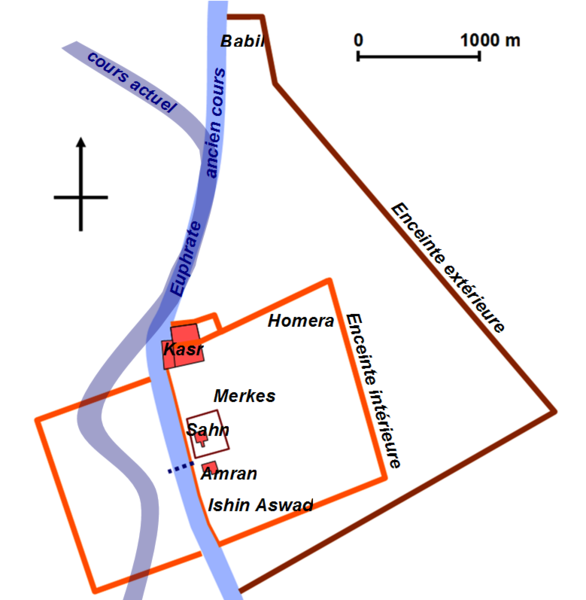
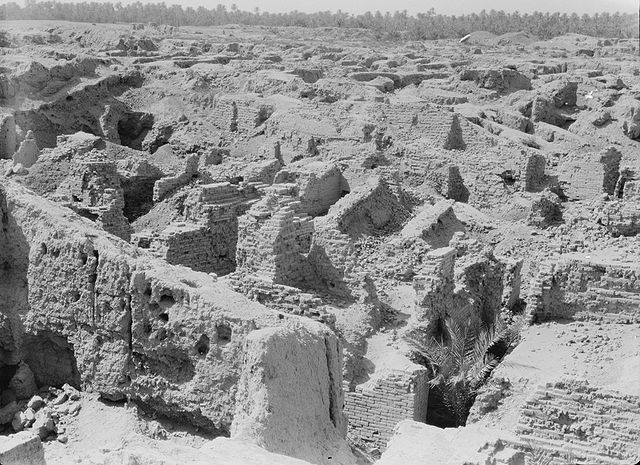
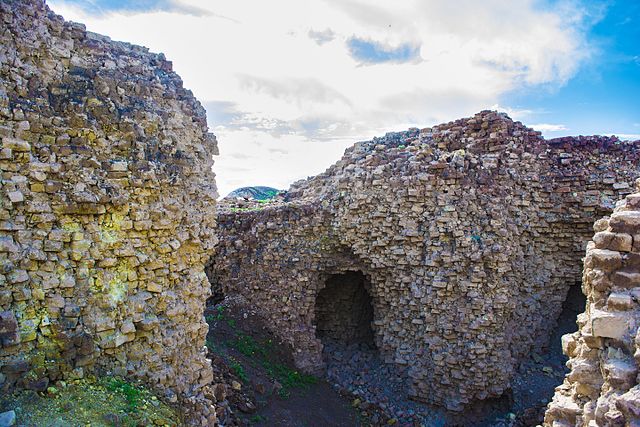
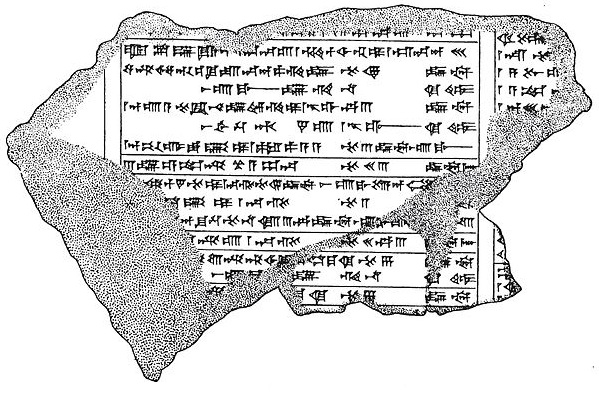
.jpg)
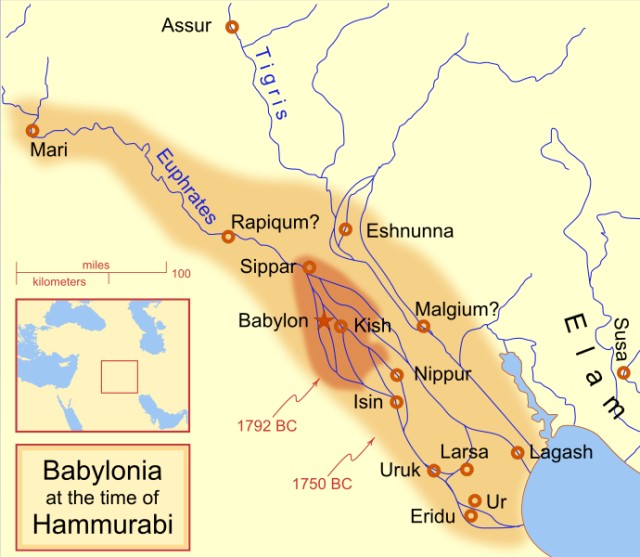
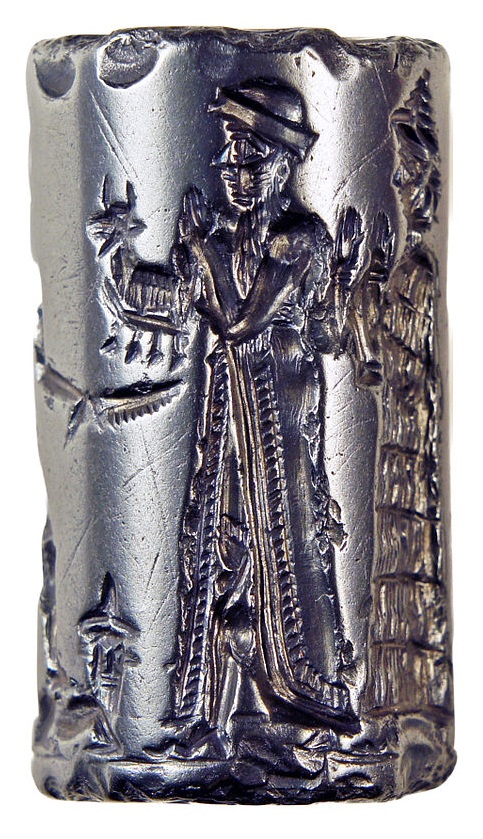
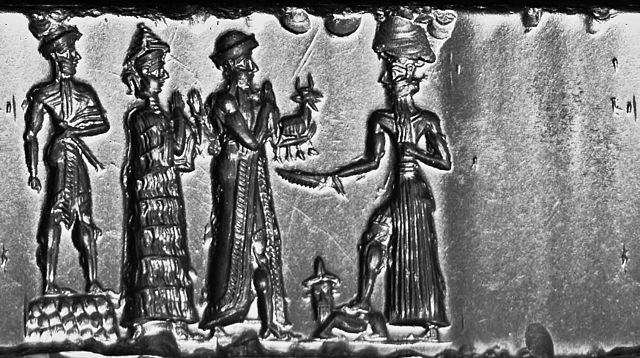

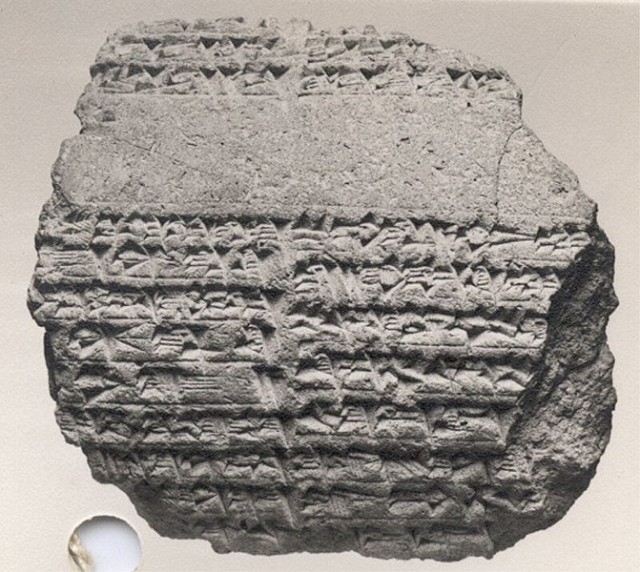
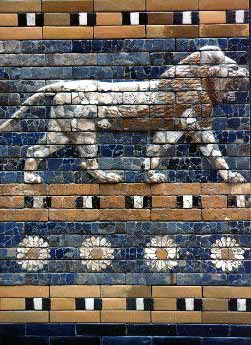
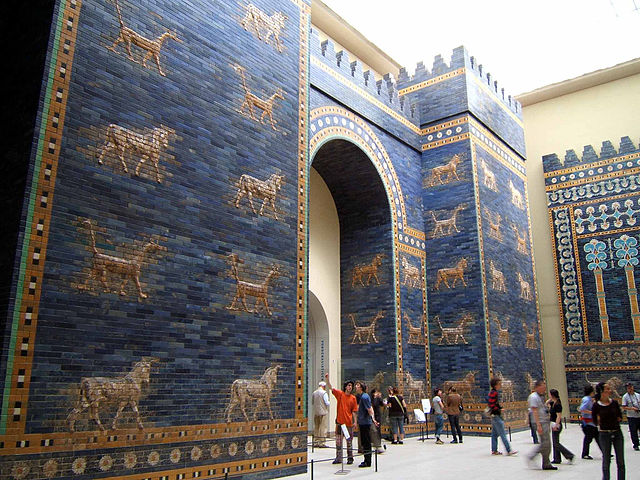
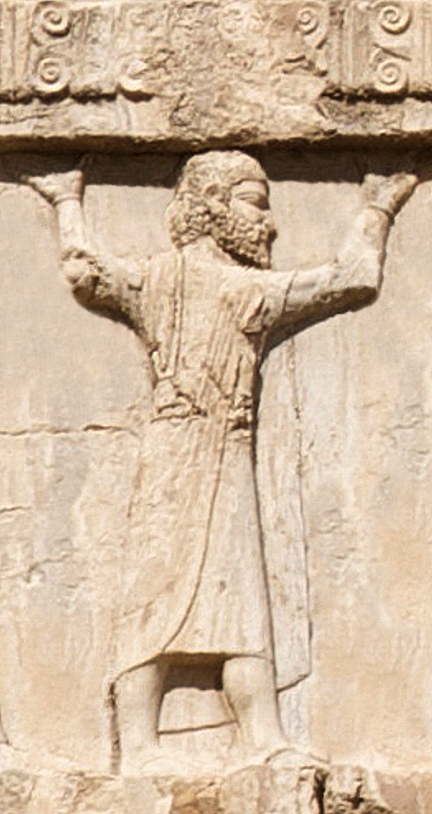

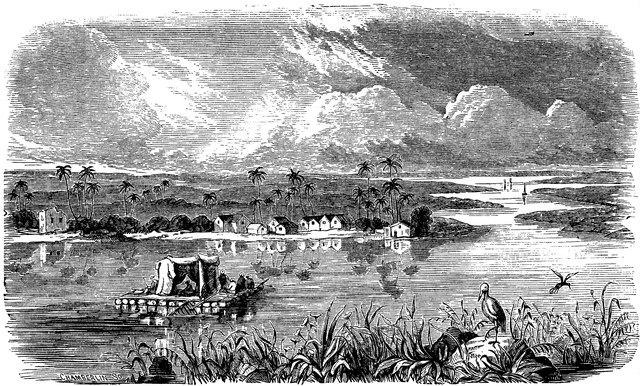
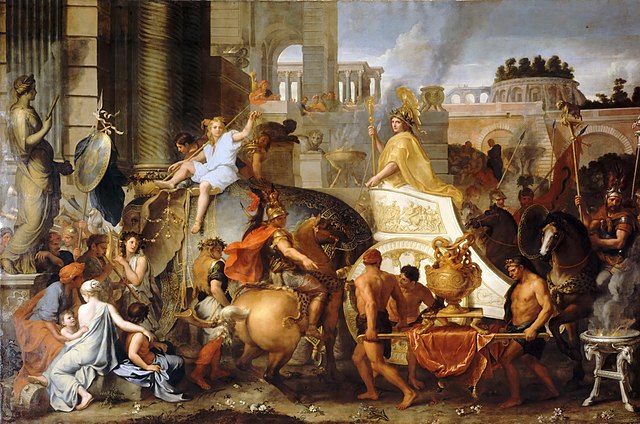
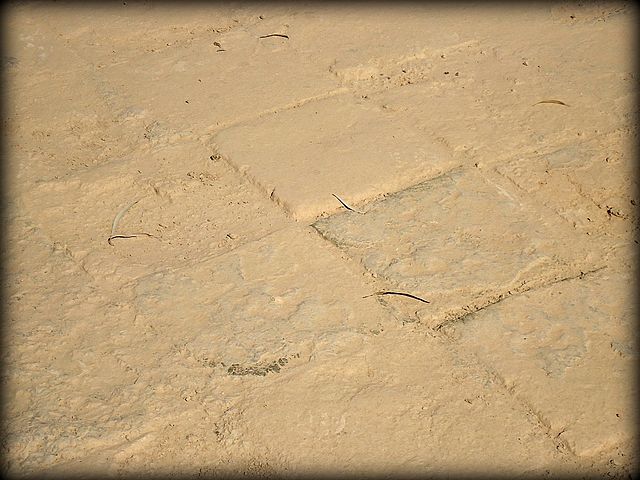
_and_aurochs_on_either_side_of_the_processional_street._Ancient_Babylon,_Mesopotamia,_Iraq.jpg)
